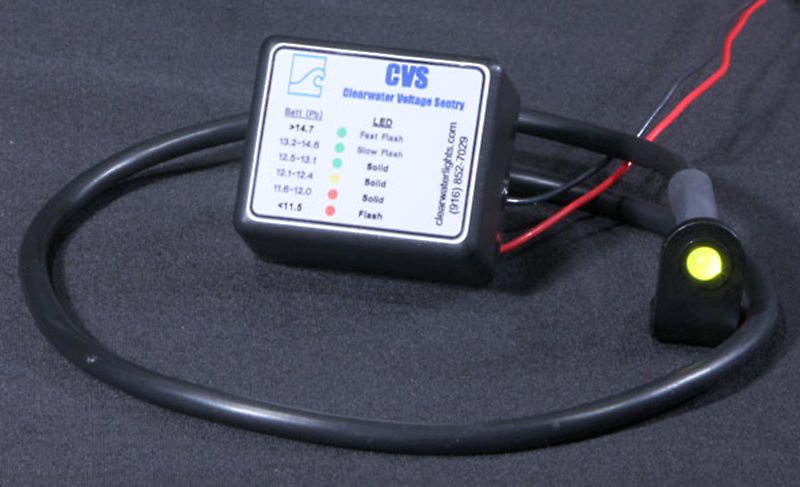
No-maintenance batteries will start their die-off process the moment they are put into service. Often they will go from fully functioning to dead with little or no warning. Replacement is the only remedy, but that won’t help you much if you’re stuck in the middle of nowhere. Stator or rectifier failure catches riders unaware at the most in-opportune moments and, of-course, serious gadget overload creates additional problems, wreaking havoc with wiring harnesses and charging systems. Why don’t bikes come with a simple voltage monitor? Everybody needs it. It is important for us to know how much power a motorcycle really has available and the general condition of the battery and charging system. A simple voltmeter could do, but won’t tell the whole story and can be cumbersome to install.
“The idea was to outfit a Suzuki DR 650 with our lights, heated grips and garment outlets,” said Clearwater’s Glenn Stasky. “We wanted a way to determine when the factory electrical system would be overloaded, so we strapped on a digital volt meter with a bungee cord and rode around town. As this was not a practical solution, we purchased a few LED volt meters found in auto parts stores and online retailers.
“In testing the purchased volt meters, we found them not only inaccurate, but we were unable to find any that matched results! In fact, none matched our calibrated HP power supply—some were 10-15 percent off! In further testing, we put them in the freezer and found the accuracy further compromised.”
Time for the digital age. Clearwater set out to design the best and most accurate voltage minder for not only motorcycles, but any vehicle with a 12-volt battery and charging system. They used a microprocessor-based system of voltage measurement to illuminate a single LED in three different colors (Red, Yellow or Green) and with six different display voltages.
If the light is green, you are good to go; yellow means there is a slight cause for attention. A red light conveys that your battery is definitely not charging; shut off accessories one at a time until you get a green or slow flashing green condition.
Flashing Red: Indicates Less than 11.5 volts (12.7 volts on Shorai battery). This is not a good condition for the battery, and could indicate a starved or defective battery. Get a charger on this battery immediately and check to see if it will come back to life.
Solid Red: Indicates between 11.6 and 12.0 volts (12.7 and 12.8 volts on Shorai battery). Weak battery, start and run the engine for a while or get a charger. If this persists after charging, the battery needs to be replaced. (This is the exact problem that occurs when a no-maintenance battery is about to starnd you in the middle of no-where)
If this occurs while the bike is running, your alternator is bad or severely overloaded.
Solid Yellow: Indicates between 12.1 and 12.4 volts (12.9 and 13.1 volts on Shorai battery). This indicates the battery needs to be recharged. If this occurs while the bike is running, it means you are drawing a lot more power than the alternator is generating, and potentially have a bad alternator.
Solid Green: Between 12.5 and 13.1 volts (13.2 and 13.4 volts on Shorai battery). Good battery condition with the bike off; poor to weak charging condition with the bike running. This can also indicate your accessories are drawing too much power. Note: some bikes do not generate sufficient power at idle. This can be normal. If you get the solid green light while your bike is idling, run the engine faster and it should start flashing green.
Slow Flashing Green: Indicates between 13.2 and 14.6 volts (13.5 and 14.8 volts on Shorai battery). The battery is charging properly.
Fast Flashing Green: The battery is over 14.6 volts (14.8 volts on Shorai battery). This indicates an abnormal overcharging situation that could indicate a faulty alternator. Get your electrical system evaluated immediately.
Embarking upon a recent cross-country trip allowed us to put the system to the acid test. A 2003 BMW K 1200 GT with a brand new BMW no-maintenance battery (the third one in 60,000 miles for this bike—indicating the life span of the BMW batteries can be as much as 5 years) and a 2012 BMW K 1600 with the original battery. As expected, the Clearwater Voltage Sentry performed flawlessly. Solid green at start up, slow flash while riding. All is good in the world of electrons.
Well almost. The K 1600 was having problems. The Voltage Sentry alerted with a yellow light on most mornings, some mornings even a solid red, but the bike would start right up and, once running, a steady green slow flash would indicate positive charging. A double check of the manual revealed that the Clearwater Voltage Sentry was telling us that the 2 year old battery would not hold a 100 percent charge overnight. A quick visit to a BMW dealer yielded only the response that the battery was within spec and could not be replaced under warranty.
Duly noted, but I knew trouble was brewing. A cold Vermont night greeted me with three inches of snow on the bikes and a K 1600 that would not start. Lights on, but no action. Bump-starting yielded nothing but this moto-journo gasping for air. Surprisingly, the Clearwater Voltage Sentry was teasing us with a GREEN light. Now what?
Armed with the knowledge that the bike actually had juice, we found the culprit: frozen snow prevented the kickstand from retracting fully and the safety switch prevented the bike from starting!
Obviously the Clearwater Voltage Sentry had earned it’s keep. It warned us about potential problems and helped troubleshoot the real issue. The CVS is easy to install and a great investment at just $59.95 plus shipping.







